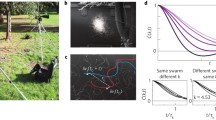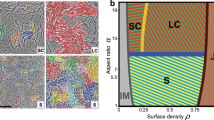Abstract.
This paper describes continuum models for swarming behavior based on non-local interactions. The interactions are assumed to influence the velocity of the organisms. The model consists of integro-differential advection-diffusion equations, with convolution terms that describe long range attraction and repulsion. We find that if density dependence in the repulsion term is of a higher order than in the attraction term, then the swarm profile is realistic: i.e. the swarm has a constant interior density, with sharp edges, as observed in biological examples. This is our main result. Linear stability analysis, singular perturbation theory, and numerical experiments reveal that weak, density-independent diffusion leads to disintegration of the swarm, but only on an exponentially large time scale. When density dependence is put into the diffusion term, we find that true, locally stable traveling band solutions occur. We further explore the effects of local and non-local density dependent drift and unequal ranges of attraction and repulsion. We compare our results with results of some local models, and find that such models cannot account for cohesive, finite swarms with realistic density profiles.
Similar content being viewed by others
Author information
Authors and Affiliations
Additional information
Received: 17 September 1997 / Revised version: 17 March 1998
Rights and permissions
About this article
Cite this article
Mogilner, A., Edelstein-Keshet, L. A non-local model for a swarm. J Math Biol 38, 534–570 (1999). https://doi.org/10.1007/s002850050158
Issue Date:
DOI: https://doi.org/10.1007/s002850050158




